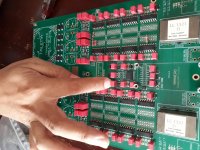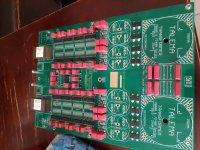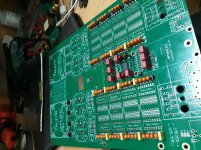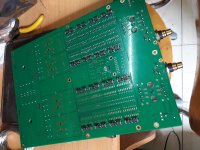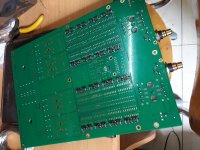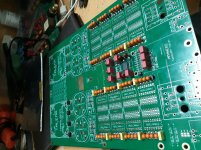Thank for Jussi Laako and PPY so much.
I have finished building this project based on V2.62 - No hum, no pop, no buzz, no gas, no noisy...anywhere.
It sounds amazing to the surprise by space, sound depth, sound fast and very analog... I never heard before, it's hard to describe.
YouTube
I have finished building this project based on V2.62 - No hum, no pop, no buzz, no gas, no noisy...anywhere.
It sounds amazing to the surprise by space, sound depth, sound fast and very analog... I never heard before, it's hard to describe.
YouTube
Attachments
Last edited:
to barrows
Yes, absolutely agree.
I've tried two different XMOS based boards with DSC (Isolated DIYinHK, SingXer X1). All of them worked very stable w/o any issues at all. DIYinHK hasn't MUTE pin and then generated loud pop at the begining of the track.
SingXer had, so no pops.
Pavel had tried noname XMOS with MUTE and confirmed stable work up to DSD512 (Linix and Windows, no pops).
New XU208 xmos USB digital audio interface U8 upgrade asynchronous amanero module for hifi amplifier A3 004 003-in Amplifier from Consumer Electronics on Aliexpress.com | Alibaba Group
Yes, absolutely agree.
I've tried two different XMOS based boards with DSC (Isolated DIYinHK, SingXer X1). All of them worked very stable w/o any issues at all. DIYinHK hasn't MUTE pin and then generated loud pop at the begining of the track.
SingXer had, so no pops.
Pavel had tried noname XMOS with MUTE and confirmed stable work up to DSD512 (Linix and Windows, no pops).
New XU208 xmos USB digital audio interface U8 upgrade asynchronous amanero module for hifi amplifier A3 004 003-in Amplifier from Consumer Electronics on Aliexpress.com | Alibaba Group
Guys,
Could please tell what is the difference (sonic/functional) between Lundahl LL 1527XL or Lundahl LL 1684?
Is the implementation of LL1684 on DSC2 board same as in Super V/I converter LL1684?
Thanks,
BTW I powered my current DSC1 board with ultracaps. The results are exceptional! Time has come for DSC2
dsc1_ultracaps_powered.jpg - Google Drive
Could please tell what is the difference (sonic/functional) between Lundahl LL 1527XL or Lundahl LL 1684?
Is the implementation of LL1684 on DSC2 board same as in Super V/I converter LL1684?
Thanks,
BTW I powered my current DSC1 board with ultracaps. The results are exceptional! Time has come for DSC2
dsc1_ultracaps_powered.jpg - Google Drive
Guys,
Could please tell what is the difference (sonic/functional) between Lundahl LL 1527XL or Lundahl LL 1684?
Is the implementation of LL1684 on DSC2 board same as in Super V/I converter LL1684?
Thanks,
BTW I powered my current DSC1 board with ultracaps. The results are exceptional! Time has come for DSC2
[/url]
Hi. Have a look at datasheets for LL1527XL and LL1684 for functional difference. I prefer LL1684 - more detailed, rich, analog sound (very subjective opinion
The recommended shematics is slightly different from Super V/I converter with LL1684 (User Guide for 2.5.2, GB thread, first message). But you can do Super V/I schematics too.
I am using schematics from UserGuide, 0,1 +0,01uF Wima FKP and 10K as a load for secondary windings.
Could you share some details (BOM, schematics) and your recommendations for ultracaps as a power supply for DSC? I'd like to try it too, but quite novice in it.
Mac OSX
Mac/OSX computers cannot output native DSD from USB, they can only output DSD data via DoP. DoP is DSD contained in a PCM data stream:
DSD 64 is contained in PCM 176.4 kHz
DSD 128 is contained in PCM 352.8
DSD 256 is contained in PCM 705.6
My understanding is that the Amanero USB receiver is not capable of receiving PCM above 384 kHz, so DSD 256, via DoP is not possible.
Now, if one uses a Mac computer as an Ethernet audio source with an Ethernet Renderer, then you can output native DSD. I do this as I write here, this looks like:
Mac Mini-Router-Ethernet-Sonore Rendu-USB-DAC
I am running Audirvana Plus on the Mini, oversampling to DSD 256, and sending native DSD 256 to the Amanero.
In all cases, if your computer is oversampling to high DSD rates I would always advise getting it away from the audio system (via Ethernet) as the computer is going to be working hard and making a fair amount of noise to do that oversampling.
I'd like to know, despite what is written on Amanero site, if under OSX is it possible to reach DSD256? txs
Mac/OSX computers cannot output native DSD from USB, they can only output DSD data via DoP. DoP is DSD contained in a PCM data stream:
DSD 64 is contained in PCM 176.4 kHz
DSD 128 is contained in PCM 352.8
DSD 256 is contained in PCM 705.6
My understanding is that the Amanero USB receiver is not capable of receiving PCM above 384 kHz, so DSD 256, via DoP is not possible.
Now, if one uses a Mac computer as an Ethernet audio source with an Ethernet Renderer, then you can output native DSD. I do this as I write here, this looks like:
Mac Mini-Router-Ethernet-Sonore Rendu-USB-DAC
I am running Audirvana Plus on the Mini, oversampling to DSD 256, and sending native DSD 256 to the Amanero.
In all cases, if your computer is oversampling to high DSD rates I would always advise getting it away from the audio system (via Ethernet) as the computer is going to be working hard and making a fair amount of noise to do that oversampling.
Yes...
Is there HQP for Mac? As long as you output via Ethernet from a Mac, then DSD 256 is possible if your playback software can do it (ROON, Audirvana, JRiver, etc). Then whatever you use as the ethernet endpoint (NAA for HQP) will also have to be capable.
BTW, Buffalo-II does DSD 256 with no issues here via an Engineered NMR Ethernet board!
Thanks for you replay, so if I use:
HQplayer OSX - Ethernet - macmini windows 10 NAA - asio amanero, Can I get dsd256?
I know it is a strange configuration but it is the one I like most.
Now I am stuck at 128 because I use a BuffaloII
G
Is there HQP for Mac? As long as you output via Ethernet from a Mac, then DSD 256 is possible if your playback software can do it (ROON, Audirvana, JRiver, etc). Then whatever you use as the ethernet endpoint (NAA for HQP) will also have to be capable.
BTW, Buffalo-II does DSD 256 with no issues here via an Engineered NMR Ethernet board!
Hi. Have a look at datasheets for LL1527XL and LL1684 for functional difference. I prefer LL1684 - more detailed, rich, analog sound (very subjective opinion)
The recommended shematics is slightly different from Super V/I converter with LL1684 (User Guide for 2.5.2, GB thread, first message). But you can do Super V/I schematics too.
I am using schematics from UserGuide, 0,1 +0,01uF Wima FKP and 10K as a load for secondary windings.
Could you share some details (BOM, schematics) and your recommendations for ultracaps as a power supply for DSC? I'd like to try it too, but quite novice in it.
Vit,
Thanks for the response and for the great designs. I plan to get DSC2.
I actually have alredy connected Super V/I ll1684 to DSC1 and it works great.
Ultracaps.
This is the best power supply I have tried so far! For reference: I already tried Salas Reflecor D with all avaliable modes, LT3042 and LifePo4. From those three LifePo4 was the best, however kind of too "slow" to my taste. Ultracaps beats them all. PRAT and silence is just gorgeous.
I tried them also on ess and akm chips. It basically brings any DAC into new level. The biggest gain you get when connected directelly to AVCC. Digital part is not so much important and could be powered with some decenet reges like ones mentioned above.
The recipe is pretty simple. You get two 2.7V 3000F (farads) ultracaps. You connect them in series. Each one have to have bleeder 1k resistor in series. Total impedance with to in series is 0,58mOhm.
You charge them with any CC/CV to which laptop PSU could be connected. E.g.: I charge mines up to 5.25V with 3A. It takes up to 30min to charge them full. Could be less time if chareged with more current.
From here you get couple of hours of audio nirvana
Caution:
1. Once you try them you will never go back to any IC regs nor any current feedback descrete designs.
2. If connected to shorted circuit 200Amps will make the PCB evapurate
ES9018K2M, ES9028Q2M, 9038Q2M DSD/I2S DAC HATs for Raspberry Pi
I'm watching this development closely. I'd like to see some well packaged applications before spending ~$100 on a rechargeable grande.
I'm watching this development closely. I'd like to see some well packaged applications before spending ~$100 on a rechargeable grande.
ES9018K2M, ES9028Q2M, 9038Q2M DSD/I2S DAC HATs for Raspberry Pi
I'm watching this development closely. I'd like to see some well packaged applications before spending ~$100 on a rechargeable grande.
Yep. That is where idea comes from. I am also observing this thread. Now the matter is to bulid PSU like PSU LPS 1.2 from uptone, where two banks of supercaps are constantly swtiching between each other. However LPS 1.2 has one drawback: it still has LT3042 on the output to regulate. While the point is to connect ultracaps directely to the load (no regulation on the path).
Hmmm.
Without regulation how stable is your voltage out from the ultra caps? I would suspect that any voltage fluctuation will result in non-linear behavior from the DSC-2, Vit/Pavel is that a correct suspicion?
I think what we would need to see to verify if a direct powering from ultracaps was really an advantage would be an impedance curve for comparison with the impedance curve of some of the better voltage regulators.
As the charge state of the ultracaps changes, I would also suspect the output impedance changes, so i would want to see the impedance curves for various charge states.
So far I have heard a lot of hype surrounding ultra caps, but I have not seen any technical information regarding noise, or output impedance curves vs. charge state, etc. My experience with LiFePO4s suggests that the belief that batteries (and caps) are not nearly as noise free as some think, the chemical reactions have a noise signature, and active voltage regulators are so good these days...
RE the LPS-1/2 type approach, there are a lot of technical difficulties with this set up, one being the noise created by the switching, and the leakage of charge noise to the other bank of batteries and the output. I am not suggesting that these difficulties can be overcome, just that it will be quite difficult to do so.
Yep. That is where idea comes from. I am also observing this thread. Now the matter is to bulid PSU like PSU LPS 1.2 from uptone, where two banks of supercaps are constantly swtiching between each other. However LPS 1.2 has one drawback: it still has LT3042 on the output to regulate. While the point is to connect ultracaps directely to the load (no regulation on the path).
Without regulation how stable is your voltage out from the ultra caps? I would suspect that any voltage fluctuation will result in non-linear behavior from the DSC-2, Vit/Pavel is that a correct suspicion?
I think what we would need to see to verify if a direct powering from ultracaps was really an advantage would be an impedance curve for comparison with the impedance curve of some of the better voltage regulators.
As the charge state of the ultracaps changes, I would also suspect the output impedance changes, so i would want to see the impedance curves for various charge states.
So far I have heard a lot of hype surrounding ultra caps, but I have not seen any technical information regarding noise, or output impedance curves vs. charge state, etc. My experience with LiFePO4s suggests that the belief that batteries (and caps) are not nearly as noise free as some think, the chemical reactions have a noise signature, and active voltage regulators are so good these days...
RE the LPS-1/2 type approach, there are a lot of technical difficulties with this set up, one being the noise created by the switching, and the leakage of charge noise to the other bank of batteries and the output. I am not suggesting that these difficulties can be overcome, just that it will be quite difficult to do so.
Without regulation voltage from the ultra caps is decreasing slowly (1-3 hours to minimum needed for DSC). The obvious conclusion is a gradual decrease in volume level. As the current consumption of DSC is fairly stable, I think no non-linear behavior will appear.
I've asked Pavel about powering DSC by ultra-caps directly. His opinion - not very good idea. Low output impedance of ultra-caps may prevent proper LC filters (power line for each shift regester) functioning. As you, he did not see any impedance curves or noise figres for ultra-caps.
In short, his answer - try, if you want and share result.
I've asked Pavel about powering DSC by ultra-caps directly. His opinion - not very good idea. Low output impedance of ultra-caps may prevent proper LC filters (power line for each shift regester) functioning. As you, he did not see any impedance curves or noise figres for ultra-caps.
In short, his answer - try, if you want and share result.
Without regulation voltage from the ultra caps is decreasing slowly (1-3 hours to minimum needed for DSC). The obvious conclusion is a gradual decrease in volume level. As the current consumption of DSC is fairly stable, I think no non-linear behavior will appear.
I've asked Pavel about powering DSC by ultra-caps directly. His opinion - not very good idea. Low output impedance of ultra-caps may prevent proper LC filters (power line for each shift regester) functioning. As you, he did not see any impedance curves or noise figres for ultra-caps.
In short, his answer - try, if you want and share result.
Yep, it all makes perfect sense to me.
E.g: Salas with his new Ultra BIB 1.3 design with impedance below 1mohm (I think it was 150uohm) recommends puting it as close to the load as possible and remove any LC or big caps on the way. E.g: I did it when powering my es9038q2m board from ultracaps.
DSC1 I have, does not have LC before shift registers, they have just have small cap (0,1uF I think) instead..
In case of DSC2 increasing impedance from ultracaps is not the problem I think (just put some resistor in series or use ultracaps with lower F value that have higher ESR).
So it all comes down to noise. Since there is no measurements avaliable for ultracaps there is no other way than just to try
BTW Having this all in mind is there any recommend regulator output impedance for powering DSC2?
Yep, it all makes perfect sense to me.
E.g: Salas with his new Ultra BIB 1.3 design with impedance below 1mohm (I think it was 150uohm) recommends puting it as close to the load as possible and remove any LC or big caps on the way. E.g: I did it when powering my es9038q2m board from ultracaps.
DSC1 I have, does not have LC before shift registers, they have just have small cap (0,1uF I think) instead..
In case of DSC2 increasing impedance from ultracaps is not the problem I think (just put some resistor in series or use ultracaps with lower F value that have higher ESR).
So it all comes down to noise. Since there is no measurements avaliable for ultracaps there is no other way than just to tryand compare.
BTW Having this all in mind is there any recommend regulator output impedance for powering DSC2?
I used LT3045/each block different. Each other IC are LC filter: 2.2uH//Wima MKP 0.1uF//Tantalum 10uF.
To 74AHCT595, i using total 6pcs tantalum (4pcs 10uF on Top and 2pcs 15uF on Bottom. Each AHCT595 are 1pc 2.2uH + 6pcs tantalum (total 70uF Parrallel) + 1 Wima 0.1uF. I tried replace 4pcs Tantalum on Top Layer by one Panasonic FC 47uF. But the Tantalum are best for Sound Quality.
I have Enla 1Fara/5.5V. Can you share schematic extracty for me try?
I fear by large capacitance will do damage the diode power (3A) and Power Transformer (2A) of me.
Attachments
Last edited:
I used LT3045/each block different. Each IC are LC filter: 2.2uH//Wima MKP 0.1uF//Tantalum 10uF.
To 74AHCT595, i using total 6pcs tantalum (4pcs 10uF on Top and 2pcs 15uF on Bottom. Each AHCT595 are 1pc 2.2uH + 6pcs tantalum (total 70uF Parrallel) + 1 Wima 0.1uF. I tried replace 4pcs Tantalum on Top Layer by one Panasonic FC 47uF. But the Tantalum are best for Sound Quality.
I have Enla 1Fara/5.5V. Can you share schematic extracty for me try?
I fear by large capacitance will do damage the diode power (3A) and Power Transformer (2A) of me.
The idea with ultracaps is different. You charge them up to some voltage then disconnect from charger when charged full and then connect them to the DSC2 board See post #950.
Have in mind what Vit123 wrote about output impedance!
It would be great if someone tried:
1. Connecting ultracaps to DSC2
2. Connecting ultracaps to DSC2 with some resistor in series to increase impedance up to suggested level.
3. Connecting ultracaps to DSC2 and removing/shorting on board LCs.
The idea with ultracaps is different. You charge them up to some voltage then disconnect from charger when charged full and then connect them to the DSC2 board See post #950.
Have in mind what Vit123 wrote about output impedance!
It would be great if someone tried:
1. Connecting ultracaps to DSC2
2. Connecting ultracaps to DSC2 with some resistor in series to increase impedance up to suggested level.
3. Connecting ultracaps to DSC2 and removing/shorting on board LCs.
Your mean are use the UltraCap as Power Bank after full charge? So, we're have power clean more.
I will try it. Tks u
Last edited:
+1So it all comes down to noise. Since there is no measurements avaliable for ultracaps there is no other way than just to tryand compare.
I'm not a guru in electronics, rather an enthusiast.BTW Having this all in mind is there any recommend regulator output impedance for powering DSC2?
Several times I've discussed power supply for DSC2 with Pavel. His opinion - built-in in LDO ADP7118 (2.5.2 / 2.6.2) with a futher filtering on the DSC board is a very good approach.
I've experimented with his older DSC2.5 version (LT3042, LT3045, TPS7A4700, Salas Reflector D) w/o any substantial improvements (IMO).
Honestly I am very interested in your approach. I'll try.
1. Connecting ultracaps to DSC2 directly (built in LDO disabled)
2. Connecting ultracaps to DSC2 with some resistor in series to increase impedance up (built in LDO disabled).
Built in LDO on DSC 2.5.2/2.6.2 can be disabled easily by shorting two jumpers.
Last edited:
Tio: To be sure, by no means am I trying to dampen anyone's enthusiasm for trying the ultra cap power approach, and I am glad you are reporting your findings, I will probably try them in some fashion myself at some point, as I am curious. I would like to see someone with a spectrum analyzer do some noise measurements of ultra caps under load to see what their noise signature is really like, and to answer the technical question as to whether they have less noise, or more, than well sorted regulated style power supplies. As long as the voltage remains steady (short term) then as Vit suggests there should be no non-linearity problem with the DSC style DACs. Although declining voltage as they discharge, and the associated declining output level of the DAC would be disturbing to me: how well do ultra caps hold their voltage through the discharge cycle?
Thinking of output Z as a single number could be misleading, I would think that the Z at the operating frequency of the shift registers would be the relevant concern, but the LC filtering on the DSC-2.x will change that. I would like to know what aspect of the ultra caps performance is responsible for the performance you hear with your DSC-1, the noise profile, or the output impedance: I guess this would require some precise measurements to know just what one is working with, does anyone know of any members capable of such measurements working with ultra caps?
Thinking of output Z as a single number could be misleading, I would think that the Z at the operating frequency of the shift registers would be the relevant concern, but the LC filtering on the DSC-2.x will change that. I would like to know what aspect of the ultra caps performance is responsible for the performance you hear with your DSC-1, the noise profile, or the output impedance: I guess this would require some precise measurements to know just what one is working with, does anyone know of any members capable of such measurements working with ultra caps?
- Home
- Source & Line
- Digital Line Level
- Signalyst DSC1
